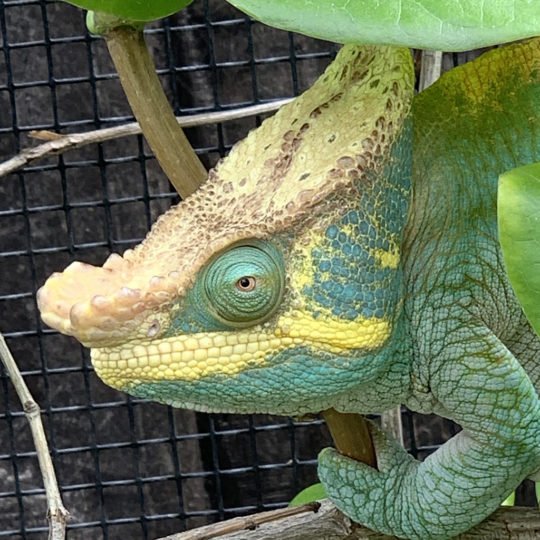
Caring for a Parson’s Chameleon requires a bit of knowledge and preparation. Their needs are quite specific, and getting it right can be the difference between a thriving pet and one that struggles. So, if you’re curious about how to properly handle and care for these fascinating reptiles, you’ve come to the right place. Let’s dive into the do’s and don’ts of keeping a Parson’s Chameleon as your new pet.
Understanding the Parson’s Chameleon
Before we get into the nitty-gritty of handling, it’s important to know exactly what a Parson’s Chameleon is. These creatures are native to Madagascar and can grow quite large—sometimes reaching lengths of up to 2 feet! Their vibrant colors, which can shift with their mood, make them captivating pets.
Here’s the thing: Parson’s Chameleons are not the easiest reptiles to care for, especially for beginners. They need specific humidity levels, temperatures, and a carefully structured habitat. If you’re thinking about bringing one home, understanding their natural behaviors and requirements is crucial.
So, let’s break down the do’s and don’ts of handling and taking care of your Parson’s Chameleon to make sure both you and your pet are happy!
Do: Create an Ideal Habitat
First things first, providing a proper habitat is essential. Think of your chameleon’s enclosure as its home, similar to how you wouldn’t feel comfortable in a messy, disorganized space. An ideal habitat should mimic their natural rainforest environment.
Here are the key aspects to consider for your chameleon’s home:
- Size: A minimum of 30-gallon tank is recommended for adults. The taller, the better, as they love to climb.
- Humidity: They thrive in humidity levels of around 50% to 70%. Misting the enclosure regularly helps maintain this level.
- Temperature: A temperature gradient is necessary, with a basking area around 85°F and a cooler end around 70°F.
Having the right plants and branches can also help your chameleon feel safe and secure. Live plants not only add beauty to the habitat but also assist in maintaining humidity levels.
Lighting Matters
You might be wondering about lighting. Chameleons need UVB light to metabolize calcium properly. Without it, they can develop serious health issues. It’s important to have a good quality UVB bulb that’s changed every six months for optimal effects.
Don’t: Handle Them Too Much
While it might be tempting to hold your Parson’s Chameleon and show it off to friends, frequent handling is not usually the best idea. Chameleons are naturally solitary creatures. They prefer to stay in their own space, and too much handling can stress them out.
Stress can manifest physically as browning colors or even lethargy. Here’s how to handle the situation:
- Limit Handling: Only handle your chameleon when necessary, like for cleaning or health checks.
- Read Their Body Language: If your chameleon is puffed up or has bright colors, it’s likely not in the mood to be handled.
- Gentle Approach: If you need to pick them up, do so slowly and support their body. Make sure to avoid grabbing them from above as this can frighten them.
Remember, the more comfortable your chameleon feels in its environment, the easier it is for you to bond with them without the need for constant handling.
Do: Feed a Balanced Diet
Feeding your Parson’s Chameleon a balanced and varied diet is crucial for their health. In the wild, they eat insects, and they’ll need a similar menu at home.
Here are some feeding tips:
- Variety is Key: Offer a mix of insects like crickets, mealworms, roaches, and waxworms to keep their diet exciting.
- Calcium and Vitamins: Dust their food with calcium and vitamin supplements several times a week—this helps prevent bone disease.
- Watch Portion Sizes: Overfeeding can cause health issues, so it’s essential to monitor how much they’re eating.
Also, keep in mind that Parson’s Chameleons can be picky eaters. If they decline food, it might be a sign of stress or health issues.
Don’t: Ignore Temperature and Humidity Levels
Ignoring the temperature and humidity in your chameleon’s environment is a big no-no. As ectothermic creatures, chameleons rely on their surroundings to regulate body temperature. If the temperature is too high or low, it can lead to serious health problems.
Make sure to regularly check the humidity levels with a hygrometer, and adjust your misting routine if necessary. If the temperature is fluctuating, consider adjusting the basking light or adding a heat lamp.
Also, be aware that low humidity can lead to dehydration, which can be harmful. Keep an eye on your chameleon for signs of dehydration, like sunken eyes.
Do: Monitor Health Closely
Keeping an eye on your Parson’s Chameleon’s health is essential. Like any pet, they can develop health issues, and catching them early can make a big difference.
Here are some signs to watch for:
- Color Changes: If your chameleon is turning brown or displaying unusual colors, it may be feeling stressed or ill.
- Appetite Changes: A sudden drop in appetite can indicate a problem.
- Lethargy: If your chameleon isn’t moving around much, it could be a sign that something’s wrong.
Regular vet check-ups are also a good idea, especially if you’re unsure about your pet’s health.
Don’t: Skip Research and Resources
Finally, never skip the research phase. Each chameleon species has unique needs, and understanding these can save you from headaches down the line.
Check out books, forums, and reputable websites dedicated to chameleon care. Reach out to experienced owners or local herpetology groups. The more you know, the better you can care for your new friend.
Understanding their behavior, habitat, and dietary needs will make a world of difference in ensuring a happy, healthy life for your Parson’s Chameleon.
In Conclusion
Owning a Parson’s Chameleon can be a rewarding experience filled with color and personality, but it comes with its own set of challenges. By following these do’s and don’ts, you can create a nurturing environment that supports their needs and allows for growth—both for you and your pet.
With dedication, a bit of research, and some patience, you can enjoy the fascinating world of chameleons without the stress. Remember, it’s all about creating a safe space where your Parson’s Chameleon can thrive. So, take a deep breath, enjoy the journey, and watch the magic unfold right in front of you!

